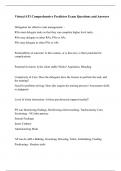Virtual ATI Comprehensive Predictor Exam Questions and Answers Delegation for effective task management. - RNs must delegate tasks so that they can complete higher level tasks. RNs may delegate to other RNs, PNs or APs. PNs may delegate to other PNs or APs. Predictability of outcome: Is this routine, or is this new, is there potential for complications Potential for harm: Is the client stable? Risks? Aspiration, Bleeding Complexity of Care: Does the delegatee have the license to perform the task, and the training? Need for problem solving: Does this require the nursing process? Assessment skills or judgment Level of client interaction: Is there psychosocial support needed? PN can Monitoring findings, Reinforcing client teaching, Tracheostomy Care, Suctioning - NG tube patency Enteral Feedings Insert Catheter Administering Meds AP can do ADLs Bathing, Grooming, Dressing, Toliet, Ambulating, Feeding Positioning - Routine tasks Bed making Specimen Collection, I and Os Vitals For stable clients Concepts of management —Strategies to identify solutions to community health problems - Planning Organizing: Controlling: Directing: Staffing: Planning: - What needs to be done, and who is going to do it Organizing: - Lines of authority, communications, and where decisions are made Directing: - Influences and motivates people to perform Controlling: - The evaluation of performance and unit goals to ensure outcomes are met Staffing: - Adequate staffing, and staffing mix Characteristics of managers: - Hold formal positions of authority and power, Possess clinical expertise, Network with members of the team, Coach subordinates, Make decisions for the organization: Resources, Budget, Hiring, and Firing Conflict Management between health care workers - Autonomy: - The ability of the client to make personal decisions, even when those decisions might not be in the client's own best interest Beneficence: - Care that is in the best interest of the client Fidelity: - Keeping one's promise to the client about care that was offered Justice: - Fair treatment in matters related to physical and psychosocial care and use of resources Nonmaleficence: - The nurse's obligation to avoid causing harm to the client Veracity: - The nurse's duty to tell the truth Examples when an incident report should be filed: - Medication errors, Procedure/treatment errors, Equipment related injuries/errors, Needlestick injuries, Client falls, Visitor/V olunteer injuries, Threat made to client or staff, Loss of property. Establishing Priorities ---Facility Protocols: Triage evaluation of peds - Emergent: Urgent Nonurgent: Expectant: Emergent: - Highest priority, life threatening injuries but also have high survival rate once stable Urgent: - Second highest priority can wait 40 -60 mins for treatment Nonurgent: - Minor injuries that are not life threatening and do not need immediate attention Expectant: - Lowest priority, expected to die, Comfort care, but not restorative care Determining Priority Care for a group of clients - Prioritizing Care for multiple home care clients - Life before limb Acute before Chronic Actual problems before potential problems Listen carefully to clients and don't assume Trends vs Transient findings Complications vs expected findings Prioritizing Care for post op clients - Airway, Breathing, Circulation, Disability, Examination/Exposure Maslow's Hierarchy - Physiological, Safety and Security, Love and Belonging, Self-esteem, Self -Actualization Speaking to a client who has a hearing Impairment Learn the clients' preferred method of communications and make accommodations. Avoid covering your mouth. Sit and face the client. Speak slowly and clearly - Encourage the use of hearing devices, lowering v ocal pitch before increasing volume Do not shout. Use brief sentences with simple words. Minimize background noise. Ask for a sign language interpreter if necessary. Write down what clients do not understand




